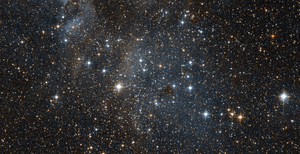NGC 1858
| Star formation region (open star cluster & emission nebula) | |
|---|---|
| NGC 1858 | |

|
|
| Photo from the Hubble Space Telescope | |
|
Position equinox : J2000.0 |
|
| Right ascension | 05h 09m 51.9s |
| declination | -68 ° 53 ′ 28 ″ |
| Further data | |
| Brightness (visual) |
9.9 likes |
| Brightness (B-band) |
9.8 likes |
| history | |
| discovery |
James Dunlop |
| Date of discovery |
August 3, 1826 |
| Catalog names | |
| NGC 1858 • ESO 56-SC074 • OGLE-CL LMC 164 | |
| Aladin previewer | |
NGC 1858 is a star formation region located on the northwestern edge of the Bar of the Large Magellanic Cloud and embedded in the H-II region N105A . The age of the newly formed star cluster in the area is estimated to be around 8 to 10 million years. The discovery of a protostar is an indication that NGC 1858 is still an active star formation region.
The area was discovered in 1826 by the astronomer James Dunlop with a 23 cm telescope and described as a star cluster surrounded by a nebula; this observation was later recorded in the New General Catalog .